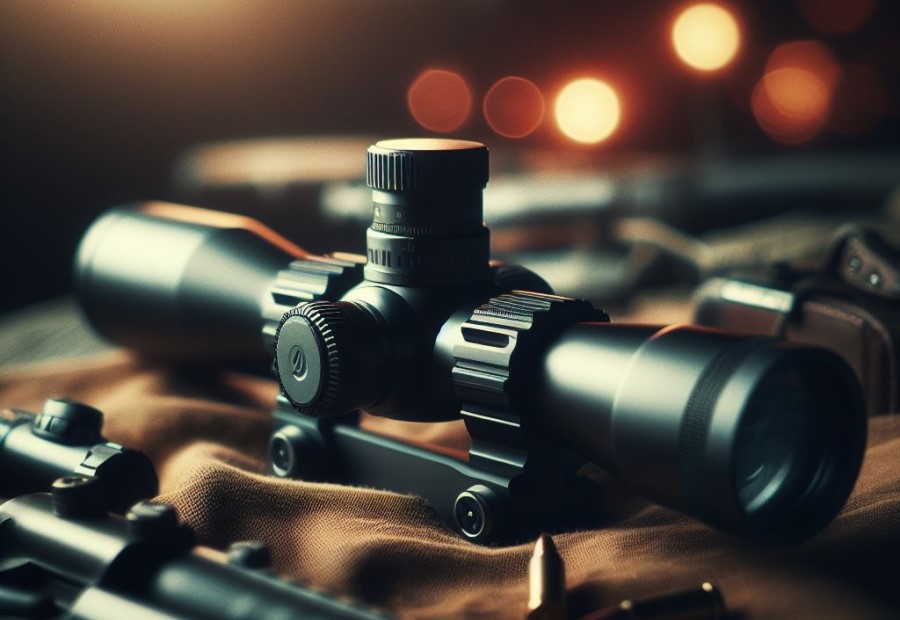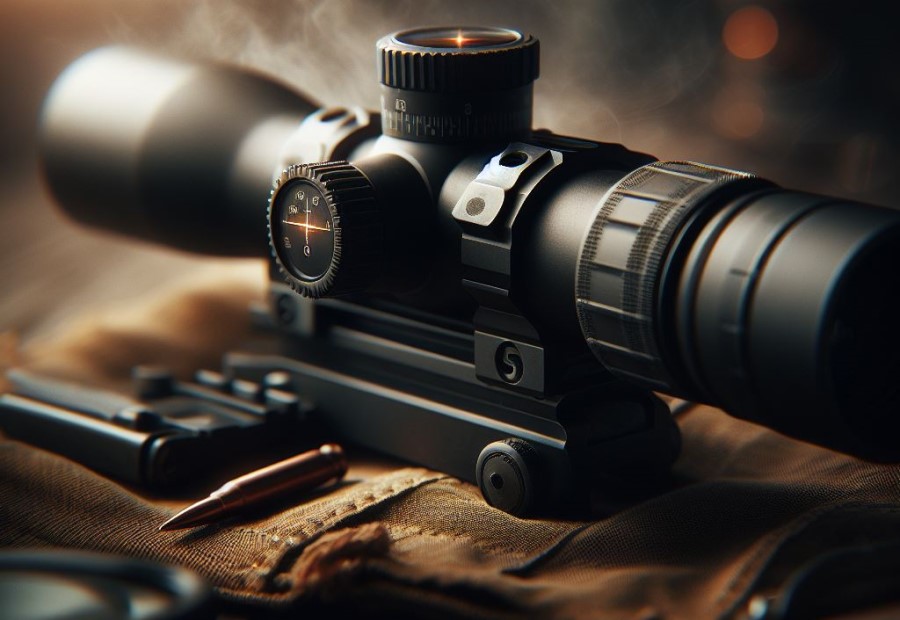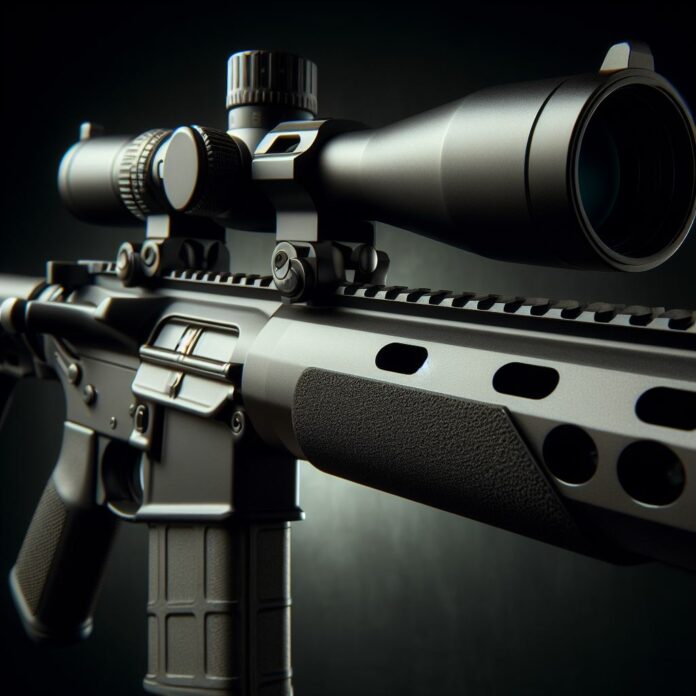When it comes to choosing a scope for a .300 Blackout rifle, there are several factors to consider. Understanding the .300 Blackout itself is the first step in making an informed decision. The .300 Blackout is a versatile and effective cartridge known for its ability to deliver superior performance in both short-range and medium-range situations.
It offers advantages such as reduced recoil, compatibility with a wide range of AR-15 platforms, and the ability to switch between supersonic and subsonic ammunition.
To choose the right scope for a .300 Blackout, it’s essential to consider the intended use of the rifle, the effective range of the .300 Blackout, the lighting conditions you’ll be shooting in, and your budget. These factors will help narrow down the options and find the perfect scope for your needs.
Finally, there are several recommended scopes for .300 Blackout available in the market that offer excellent performance and value.
Understanding the .300 Blackout

To understand the .300 Blackout, let’s take a look at its key features:
| Caliber | .300 Blackout |
| Bullet Diameter | .308 inches (7.62mm) |
| Maximum Range | 460 meters |
| Effective Range | 200 meters |
| Primary Use | Close quarter combat, home defense, and hunting |
Fact: The .300 Blackout was specifically designed to provide a reliable and versatile option for use with standard AR-15 rifles.
What is a .300 Blackout?
The .300 Blackout is a type of rifle cartridge that was developed for use in firearms chambered for the .223 Remington/5.56mm NATO cartridge. What is a .300 Blackout?
It was designed to offer better performance in short-barreled rifles and to provide a larger projectile for increased stopping power. The .300 Blackout has a bullet diameter of .308 inches and operates at a lower velocity than the .223 Remington/5.56mm NATO, making it suitable for suppressed firearms.
The .300 Blackout offers several advantages over other rifle cartridges. Firstly, it can be used with existing AR-15 magazines and lower receivers, requiring only a barrel change. This makes it a cost-effective option for those who already own an AR-15 platform rifle.
Secondly, the .300 Blackout offers excellent versatility, allowing shooters to easily switch between subsonic and supersonic loads depending on their needs. Subsonic loads are ideal for shooting with a suppressor, providing quiet and effective shooting. Supersonic loads are more powerful, offering increased velocity and energy for greater range and stopping power.
When considering the use of a .300 Blackout, it’s important to understand its capabilities and limitations. The effective range of the .300 Blackout is generally around 300 yards, making it suitable for short to medium-range engagements.
The cartridge performs well in close-quarters situations, making it popular for home defense and tactical applications. Additionally, the .300 Blackout performs particularly well with shorter barrels, providing good accuracy and reliable terminal ballistics.
What are the Advantages of Using a .300 Blackout?
The advantages of using a .300 Blackout are numerous and make it a popular choice among shooters and hunters:
- Versatility: The .300 Blackout is a versatile cartridge that can be used in both short-barreled rifles and full-sized rifles. It offers the flexibility to switch between supersonic and subsonic loads, making it suitable for various shooting applications.
- Suppressed Shooting: One of the main advantages of the .300 Blackout is its ability to be fired quietly when using subsonic ammunition. When paired with a suppressor, it provides a stealthy shooting experience, ideal for shooting in sensitive areas or for reducing noise levels.
- Close Quarters Combat: The .300 Blackout is highly effective in close quarters combat situations. Its performance is optimized for short barrel lengths, making it an excellent choice for home defense or tactical operations in confined spaces.
- Increased Magazine Capacity: The .300 Blackout offers similar ballistics to the .223/5.56mm round but uses larger diameter bullets. This allows shooters to utilize standard AR-15 magazines and retain higher round capacity while enjoying the benefits of a larger bullet.
- Ballistic Performance: The .300 Blackout performs well in terms of power, accuracy, and range. It has a flat trajectory and delivers significant energy on target, making it effective for hunting medium-sized game as well.
Considering these advantages, the .300 Blackout is a versatile and powerful cartridge suited for a variety of shooting scenarios, making it an excellent choice for shooters and hunters alike.
Factors to Consider When Choosing a Scope

When it comes to choosing a scope for a .300 Blackout, several factors play a crucial role. From the magnification power to the objective lens size, reticle type, eye relief, and adjustability, each aspect adds a unique dimension to your shooting experience.
In this section, we will unlock the secrets behind selecting the perfect scope for your needs. So, fasten your seatbelts and get ready to dive into the world of precision and accuracy. Let’s explore the key factors and make an informed decision that will elevate your shooting game to new heights.
Magnification Power
The magnification power is a crucial factor to consider when selecting a scope for a .300 Blackout rifle. It plays a significant role in determining the clarity and proximity of your target. Opting for a higher magnification power enables you to take precise shots at longer distances, whereas a lower power provides a wider field of view for closer targets.
To enhance your understanding of magnification power, here is a table that compares different ranges of magnification and their recommended uses for a .300 Blackout rifle:
| Magnification Power | Recommended Use |
|---|---|
| 1-4x | Close-range shooting, fast target acquisition |
| 4-12x | Versatile range, suitable for various distances |
| 6-24x | Long-range shooting, precision targeting |
Keep in mind that a higher magnification allows you to observe finer details but may also narrow your field of view. In order to select the appropriate magnification power for your scope, consider your shooting requirements and the distances at which you will engage targets.
Objective Lens Size
| Objective Lens Size | Key Considerations |
| 40mm | A 40mm objective lens size is a versatile choice for a .300 Blackout scope. It offers a good balance between light gathering capability and size. It allows for sufficient light transmission, especially in low-light conditions, without adding too much weight to the scope. This size is suitable for a wide range of shooting applications. |
| 50mm | If you plan on shooting in low-light situations or at longer distances, a scope with a 50mm objective lens size is ideal. The larger lens diameter allows for more light to enter the scope, resulting in brighter and clearer images. It enhances visibility in low-light conditions and improves image clarity at higher magnifications. |
| 24mm | A 24mm objective lens size is more compact and lightweight, making it suitable for tactical or close-range shooting. While it may not gather as much light as larger objective lens sizes, it offers a wider field of view and faster target acquisition. If you primarily engage in close-quarters combat or need a more maneuverable setup, consider a scope with a 24mm objective lens size. |
Reticle Type
When selecting a reticle type for your scope with a .300 Blackout, there are several factors to consider. First, opt for a simple and clean reticle type like a duplex or dot reticle. These types of reticles are user-friendly and allow for quick target acquisition. Additionally, think about whether you prefer a fixed or variable magnification scope.
For short to medium range shooting, a low to medium power scope with a simple reticle will be most suitable. It is also important to look for a reticle type that has adjustable brightness settings, particularly if you plan on shooting in different lighting conditions.
Another consideration is whether to go for a mil-dot or MOA reticle, depending on your personal preference and familiarity. Both types provide precise aiming points for elevation and windage adjustment.
Furthermore, think about selecting a reticle type that incorporates bullet drop compensation (BDC) marks, such as hash marks or circles, if you will be shooting at various distances.
Lastly, if you intend to use your .300 Blackout for tactical purposes, consider a reticle with additional features like range-finding capabilities or wind hold dots. By taking these factors into account, you can choose a reticle type for your scope that meets your shooting needs and enhances your accuracy with a .300 Blackout.
Eye Relief
When selecting a scope for a .300 Blackout rifle, one crucial consideration is eye relief. Eye relief refers to the distance between your eye and the scope eyepiece, where you can maintain a complete field of view without any loss of vision or discomfort.
- Eye relief is of utmost importance for safety reasons because it prevents the scope from striking your face during rifle recoil.
- Adequate eye relief also enables improved target acquisition and provides a clear and comfortable view.
- For a .300 Blackout rifle, it is recommended to have a minimum eye relief of 3.5 inches to ensure safety and a proper field of view.
- Shooters who prefer a more extended shooting position or those utilizing magnifiers or night vision devices can benefit from longer eye relief.
It is important to note that eye relief may vary depending on the specific model of the scope, so it is essential to review the manufacturer’s specifications before making any purchase.
Adjustability and Turrets
When selecting a .300 Blackout scope, it is crucial to consider its adjustability and turrets. These factors play a significant role in enhancing the performance and accuracy of your rifle.
- Adjustability: Look for a scope that offers adjustable features such as windage and elevation. This allows you to finely tune your aim and compensate for variables like wind and bullet drop.
- Turrets: Opt for a scope with easily adjustable turrets. These turrets enable you to make precise adjustments to your scope settings without requiring extra tools. Look for turrets that are easy to grip and have clear markings for quick and accurate modifications.
Having optimal adjustability and turrets on your scope can significantly enhance your shooting experience with a .300 Blackout. It enables you to make precise adjustments on the go, ensuring that your shots consistently hit the target.
Choosing the Right Scope for a .300 Blackout

When choosing the right scope for a .300 Blackout, consider the following factors:
- Magnification: Look for a scope with variable magnification, such as 1-6x or 3-9x, to accommodate different shooting distances.
- Reticle: Opt for a reticle designed for quick target acquisition, such as a BDC or illuminated reticle.
- Objective Lens Size: A larger objective lens, like 40mm or 50mm, will allow more light transmission and better performance in low-light conditions.
- Tube Diameter: Choose a scope with a 30mm or 34mm tube for increased strength and light transmission.
- Eye Relief: Ensure the scope has sufficient eye relief, typically around 3-4 inches, to prevent recoil-related injuries.
- Durability: Look for scopes with shockproof, fogproof, and waterproof features to withstand different weather conditions.
- Brand Reputation: Consider reputable scope brands known for their quality and customer satisfaction.
Fact: The .300 Blackout cartridge was designed to provide reliable magazine feeding and ballistics for the AR-15 platform and can be used for both supersonic and subsonic rounds.
What is the Intended Use of the Rifle?
The intended use of the rifle is an important factor to consider when choosing a scope for a .300 Blackout. The intended use refers to the purpose or activity for which the rifle will be used.
Some common intended uses of a .300 Blackout rifle include hunting, target shooting, home defense, and tactical applications. Each of these uses may require different features and specifications in a scope.
For hunting, a scope with a moderate to high magnification power is beneficial for accurate shots at various distances. A larger objective lens size allows for better light transmission and visibility in low-light conditions, which can be advantageous during early morning or late evening hunts.
In target shooting, a scope with precise adjustments and a clear reticle type is important for accurate long-range shots. Additionally, a scope with a wider field of view may be preferable for quick target acquisition.
When considering home defense or tactical applications, a scope with a wide field of view and a low magnification power can help in close-quarters situations. Quick target acquisition and a durable construction are also desirable features.
Pro-tip: Before purchasing a scope, it’s crucial to clearly identify the intended use of your rifle. This will ensure that you select a scope that meets your specific needs and enhances your shooting experience.
What are the Lighting Conditions?
When selecting a scope for a .300 Blackout firearm, it is essential to consider the lighting conditions under which the rifle will be utilized. The lighting conditions have a significant impact on visibility and shooting precision.
- When dealing with low light circumstances like dusk or dawn, it is crucial to have a scope that offers exceptional light transmission. Look for scopes with top-notch lenses and coatings that optimize brightness and clarity.
- For hunting or shooting in environments with dim lighting, contemplate scopes with illuminated reticles. This feature enables the shooter to clearly see the aiming point, even in low light.
- If you frequently engage in shooting activities under bright sunlight, opt for a scope with a sunshade to minimize glare and prevent light reflection on the lens. This will assist in maintaining a clear and unimpeded view of the desired target.
- Furthermore, consider the magnification power of the scope. Higher magnification can be advantageous in low light conditions, as it aids in gathering more light and producing a brighter image. Nonetheless, it is important to note that excessively high magnification may compromise image quality and diminish brightness.
By taking into account the specific lighting conditions in which you will be using your .300 Blackout rifle, you can select a scope that enhances visibility and elevates shooting performance.
Frequently Asked Questions
How do I choose a scope for a .300 Blackout?
Choosing a scope for a .300 Blackout requires considering several factors. First, determine your intended use, such as hunting, 3-Gun competitions, or close-quarter combat. For hunting, look for a scope with excellent light transmission and an illuminated reticle for low light conditions. For short-range purposes or close-quarter combat, consider a lower magnification scope or a red dot sight.
Second, consider factors like picture clarity, durability, and value. Look for a scope with clear, high-quality glass, fully coated lenses, and a scratch-resistant lens coating. Also, ensure the scope is durable and waterproof, fog-resistant, and shock-resistant. Lastly, research trusted brands and read reviews to ensure you are choosing a reliable scope.
What are the top recommended scopes for a .300 Blackout?
Some of the top recommended scopes for a .300 Blackout include:
- Trijicon ACOG: Known for its durability, this scope offers a 4X magnification and a BDC reticle that accommodates both supersonic and subsonic rounds.
- Vortex Crossfire II 4-16×50: This scope is designed for mid-to-long-range shooting and features a Dead-Hold BDC reticle and fully multi-coated lens.
- Primary Arms SLx 1-6×24: Designed specifically for .300 Blackout, this scope features an ACSS BDC reticle that works well for both supersonic and subsonic loads.
Are there scopes with reticles specifically designed for .300 Blackout?
Yes, there are scopes with reticles specifically designed for .300 Blackout rounds. These reticles often include bullet drop compensation (BDC) markings for both supersonic and subsonic rounds. However, it is not essential to have a scope with a specific reticle for .300 Blackout, and scopes with standard mil-dot reticles can still be effective.
What are the best scopes for close-quarter combat or home defense with a .300 Blackout?
For close-quarter combat or home defense with a .300 Blackout, it is recommended to use a low magnification scope or a red dot sight. Some recommended options include the Vortex Strike Eagle 1-6×24 and the Primary Arms SLx 1-6×24. These scopes offer clear glass, a fast focus dial, and illuminated reticles suitable for close-range engagements.
Can I use a .300 Blackout scope for other calibers or firearms?
Yes, a .300 Blackout scope can typically be used for other calibers or firearms, particularly those within the AR-15 platform. However, it is always important to ensure that the scope is appropriate for the specific firearm and its ballistics.
Additionally, it is recommended to consider the intended use and the specific features needed for optimal performance with the chosen caliber.
What is the difference between first focal plane (FFP) and second focal plane (SFP) reticles?
First focal plane (FFP) reticles and second focal plane (SFP) reticles refer to the placement of the reticle within the scope. In an FFP reticle, the reticle’s size changes as the magnification level is adjusted, allowing for accurate estimations of range at any magnification.
In an SFP reticle, the reticle’s size remains the same regardless of the magnification level, which may affect the accuracy of range estimations at different magnification settings. It is important to consider the reticle placement when choosing a scope, depending on your specific shooting needs and preferences.

